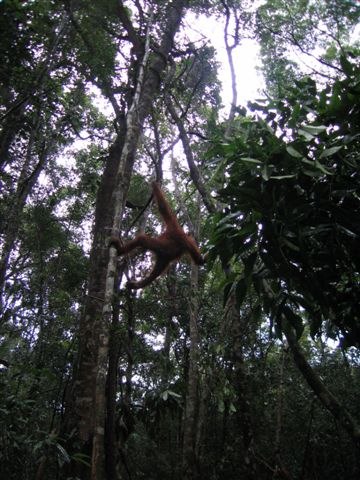Bernadette thanks for your interest and yesterday’s question: Is the feeding site to ensure that the released orangutans can get food if they aren’t able to in the wild? I’d like to know more about how the release site will function? Is it a huge enclosure, or is it really the wild? Rehabilitated orangutans, released into the Lamandau Wildlife Reserve, are given supplementary feedings every day. This ensures they maintain their physical condition during the transition period from life at the Orangutan Care Centre & Quarantine (OCCQ) to life in the wild. The feedings also decrease potential competition with wild orangutans and they allow us to monitor the released individuals. Frequently, the only time they are seen is when they come in for food.
Orangutans in Lamandau (sorry the photos are so dark).
As for the question of how wild it is: it is definitely wild. The Lamandau Wildlife Reserve has no fences. It is 760km2 most of which is forested. As you can see from the attached map, our guard posts protect the buffer zone (between the Reserve and the Lamandau River) which adds to the area available to the orangutans.
Just yesterday we counted six species of birds as we ate lunch on the jetty. During the time the volunteers were staying there they saw, red leaf-eating monkeys, proboscis monkeys, pig-tailed macaques (very rarely seen), a mouse deer and some snakes (admittedly the snakes were not so popular!).
They also saw leeches. However, let’s not be too hard on leeches as abundant leeches are a good indicator of a healthy mammal population; after all they do not exist just to prey on you and me. So even the leeches help answer your question. It is wild.
Thanks,
Stephen





